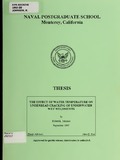Environmental effects on underwater optical transmission
| dc.contributor.author | Chu, Peter C. | |
| dc.contributor.author | Breshears, Brian F. | |
| dc.contributor.author | Cullen, Alexander J. | |
| dc.contributor.author | Hammerer, Ross F. | |
| dc.contributor.author | Martinez, Ramon P. | |
| dc.contributor.author | Phung, Thai Q. | |
| dc.contributor.author | Margolina, Tetyana | |
| dc.contributor.author | Fan, Chenwu | |
| dc.date.accessioned | 2019-01-10T23:22:39Z | |
| dc.date.available | 2019-01-10T23:22:39Z | |
| dc.date.issued | 2018 | |
| dc.identifier.citation | Chu, P.C., B.F. Breshears, A. J. Cullen, R.F. Hammerer, R.P. Martinez, T.Q. Phung, T. Margolina, and C.W. Fan, 2017: Environmental effects on underwater optical transmission. Proc. SPIE 10186, Ocean Sensing and Monitoring IX, 1018609 (May 22, 2017); doi:10.1117/12.2256466 | en_US |
| dc.identifier.uri | https://hdl.handle.net/10945/60916 | |
| dc.description.abstract | Optical communication/detection systems have potential to get around some limitations of current acoustic communications and detection systems especially increased fleet and port security in noisy littoral waters. Identification of environmental effects on underwater optical transmission is the key to the success of using optics for underwater communication and detection. This paper is to answer the question “What are the transfer and correlation functions that relate measurements of hydrographic to optical parameters?” Hydrographic and optical data have been collected from the Naval Oceanographic Office survey ships with the High Intake Defined Excitation (HIDEX) photometer and sea gliders with optical back scattering sensor in various Navy interested areas such as the Arabian Gulf, Gulf of Oman, east Asian marginal seas, and Adriatic Sea. The data include temperature, salinity, bioluminescence, chlorophyll-a fluorescence, transmissivity at two different wavelengths (TRed at 670 nm, TBlue at 490 nm), and back scattering coefficient (bRed at 700 nm, bBlue at 470 nm). Transfer and correlation functions between the hydrographic and optical parameters are obtained. Bioluminescence and fluorescence maxima, transmissivity minimum with their corresponding depths, red and blue laser beam peak attenuation coefficients are identified from the optical profiles. Evident correlations are found between the ocean mixed layer depth and the blue and red laser beam peak attenuation coefficients, bioluminescence and fluorescence maxima in the Adriatic Sea, Arabian Gulf, Gulf of Oman, and Philippine Sea. Based on the observational data, an effective algorithm is recommended for solving the radiative transfer equation (RTE) for predicting underwater laser radiance. | en_US |
| dc.rights | This publication is a work of the U.S. Government as defined in Title 17, United States Code, Section 101. Copyright protection is not available for this work in the United States. | en_US |
| dc.title | Environmental effects on underwater optical transmission | en_US |
| dc.type | Conference Paper | en_US |
| dc.contributor.corporate | Naval Postgraduate School (U.S.) | en_US |
| dc.contributor.department | Oceanography | en_US |





